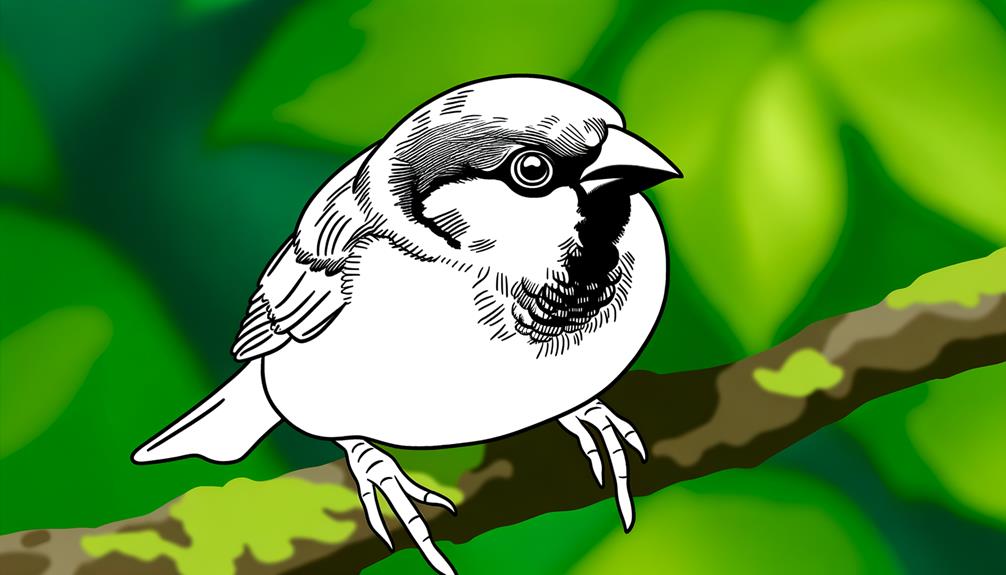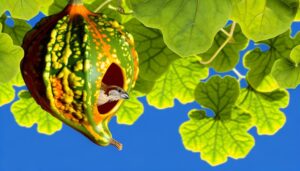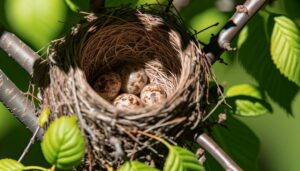Measuring the Smartness of House Sparrows
House sparrows exhibit significant cognitive abilities, demonstrating problem-solving skills and cognitive flexibility. They excel in urban adaptability, illustrating advanced memory and associative learning.
Sparrows recognize individual humans and utilize observational learning for food acquisition. Their innovative behaviors include tool use and exploiting anthropogenic resources for nesting.
House sparrows display intricate social intelligence, communicating through vocalizations and body language within complex social hierarchies. Their advanced spatial memory enables them to recall the exact locations of hidden food items.
Studying these behaviors reveals much about their intelligence and adaptive strategies.

Key Takeaways
- House sparrows exhibit advanced problem-solving skills, including innovative food retrieval using tools.
- They display cognitive flexibility and rapid learning behaviors, especially in urban environments.
- Sparrows can recognize and remember individual humans who provide food.
- They have remarkable spatial memory, recalling specific locations of hidden food items after hours.
- House sparrows engage in complex social behaviors and sophisticated communication systems, including vocalizations and body language cues.
Problem-Solving Skills
House sparrows (Passer domesticus) frequently exhibit remarkable problem-solving skills, as evidenced by their ability to navigate complex urban environments and exploit novel food sources. Observational studies have documented their capacity to learn and adapt behaviors rapidly, such as opening automatic doors by triggering sensors.
These birds demonstrate cognitive flexibility in food acquisition, employing tactics like dislodging insects from crevices or scavenging from human refuse. Research has shown that house sparrows can also recognize and remember individual humans who provide food, indicating advanced memory and associative learning abilities.
Their problem-solving prowess is further highlighted by their use of tools, albeit rudimentary, to access otherwise unreachable resources. Such behaviors underscore their advanced cognitive functions and adaptability in dynamic settings.
Urban Adaptability
House sparrows exhibit remarkable urban adaptability through their resourceful nesting habits, such as utilizing building crevices and man-made structures for shelter.
Their ability to exploit innovative food sources, including scavenging from human refuse and adapting to novel dietary items, further underscores their resilience in urban environments.
These behaviors offer compelling evidence of their capacity to thrive amid anthropogenic changes.
Resourceful Nesting Habits
Exhibiting remarkable urban adaptability, Passer domesticus demonstrates resourceful nesting habits by utilizing a wide array of man-made structures such as eaves, gutters, and cavities in buildings. These sparrows exhibit a high degree of behavioral plasticity, selecting nesting sites that offer protection from predators and environmental elements.
Studies indicate that their choice of nesting locations correlates with reduced predation risk and enhanced reproductive success. By exploiting anthropogenic structures, house sparrows mitigate the limited availability of natural nesting sites in urban environments.
This adaptability not only underscores their ecological intelligence but also highlights their ability to thrive in diverse and often challenging habitats. Consequently, their nesting habits serve as a demonstration of their evolutionary success and resilience in urban ecosystems.
Innovative Food Sources
Through ingenious foraging strategies, Passer domesticus has adapted to urban environments by exploiting a diverse array of anthropogenic food sources, ranging from discarded human food to insects attracted to artificial lights. This adaptability is evidenced by their ability to consume a varied diet, including grains, seeds, and even small invertebrates.
Studies indicate that urban sparrows exhibit higher foraging efficiency compared to their rural counterparts, likely due to the abundance of easily accessible, high-calorie food sources. Additionally, their cognitive flexibility allows them to quickly learn and remember the locations of reliable food supplies.
This behavioral plasticity not only enhances their survival but also contributes to their success in densely populated areas, underscoring their remarkable urban adaptability.
Tool Use
House sparrows have exhibited remarkable tool use behaviors, particularly in the domains of innovative food retrieval and nest construction techniques.
Research has documented instances of these birds utilizing twigs and leaves to extract insects from crevices, demonstrating advanced problem-solving skills.
Such evidence underscores the cognitive capabilities of house sparrows, challenging previous assumptions about avian intelligence.
Innovative Food Retrieval
In a remarkable display of cognitive flexibility, house sparrows have been observed utilizing tools to access otherwise unreachable food sources, thereby demonstrating a sophisticated level of problem-solving ability.
Documented instances include sparrows using twigs or leaves to dislodge insects from crevices and employing these makeshift tools to manipulate seeds or crumbs from tight spaces. Such behavior highlights their capacity for innovative food retrieval, an attribute more commonly associated with higher-order avian species.
Field studies indicate that this tool use is not random but a learned behavior, suggesting a potential for cultural transmission among sparrow populations. These observations contribute significantly to our understanding of avian intelligence, positioning house sparrows as capable of complex, adaptive behaviors in their quest for sustenance.
Nest Construction Techniques
Sparrows exhibit a remarkable proficiency in nest construction, often incorporating a diverse array of materials and demonstrating a level of tool use that underscores their adaptive ingenuity. Their nests are typically composed of twigs, grasses, and feathers, meticulously arranged to provide insulation and protection. Research has documented that sparrows will also utilize man-made objects, such as string and paper, to enhance nest stability.
| Material | Purpose | Source |
|---|---|---|
| Twigs | Structural support | Trees, shrubs |
| Grasses | Insulation | Ground, vegetation |
| Feathers | Soft lining | Shed feathers, other birds |
This resourcefulness in material selection and application exemplifies their cognitive capabilities. Additionally, the consistent choice of functional items reflects an understanding of material properties, suggesting a sophisticated level of environmental interaction and tool use.
Problem-Solving Skills
Recent studies have revealed that sparrows exhibit advanced problem-solving skills, particularly in their use of tools to access food and construct nests. Observations have shown sparrows using twigs to extract insects from crevices, demonstrating a level of cognitive function previously underestimated in small passerine birds.
Experimental setups have documented sparrows manipulating objects, such as small sticks, to retrieve food from narrow openings, showcasing their ability to understand and apply cause-and-effect relationships. Additionally, sparrows have been observed incorporating human-made materials, like string or paper, into their nests, indicating adaptability and resourcefulness.
These findings underscore the sparrow's capacity for innovative behavior, suggesting a higher degree of intelligence and cognitive flexibility than traditionally recognized in avian species.
Learning From Humans
Observations have indicated that house sparrows exhibit remarkable cognitive abilities by mimicking human behaviors to solve complex problems. Particularly, ethological studies have documented instances of these birds learning to open automatic doors by observing human interaction with sensors. Such behavioral adaptation demonstrates a high level of associative learning and problem-solving acumen.
Additionally, house sparrows have been seen scavenging near human habitats and timing their activities to coincide with human meal times, indicating temporal learning and the ability to predict human behavior. Research supports that these birds possess an acute memory retention capability, enabling them to remember successful strategies over extended periods.
This evidence underscores the house sparrow's capacity for observational learning and cognitive flexibility in anthropogenic environments.
Social Intelligence
Beyond their ability to learn from humans, house sparrows exhibit complex social intelligence, characterized by sophisticated communication systems and intricate social hierarchies.
These birds display a high degree of social learning, where individuals observe and imitate the actions of conspecifics, enhancing their adaptive capabilities.
Hierarchical structures within sparrow flocks are evidenced through dominant-subordinate interactions, which regulate access to resources such as food and nesting sites.
Additionally, house sparrows engage in allopreening, a behavior that not only strengthens social bonds but also serves hygienic purposes.
Observational studies have documented instances of cooperative breeding, where non-parent individuals assist in feeding and protecting the young, indicating advanced social coordination and altruistic behavior within their communities.
Communication Abilities
House sparrows employ a diverse range of vocalizations and visual signals to convey information, regulate social interactions, and coordinate group behavior. Their communication repertoire includes various calls and songs, each serving distinct purposes such as alarm signaling, mate attraction, and territory defense. These vocalizations are often complex, exhibiting frequency modulation and temporal patterns that can vary according to context.
- Alarm calls: Sharp, high-pitched sounds to warn of predators.
- Contact calls: Soft, repetitive notes to maintain group cohesion.
- Begging calls: High-frequency sounds from juveniles soliciting food.
- Song: Melodic sequences used primarily by males to attract mates.
- Visual displays: Posture and plumage changes to signal aggression or submission.
Such nuanced communication underscores the cognitive sophistication of house sparrows.
Memory and Recall
Recent studies have shown that house sparrows possess remarkable memory and recall abilities, enabling them to navigate complex environments and remember the locations of food sources over extended periods. Cognitive research highlights their capacity for spatial memory, allowing them to efficiently exploit feeding sites.
Experimental evidence shows that sparrows can recall the specific locations of hidden food items after several hours, indicating a sophisticated level of cognitive mapping. Neurobiological studies suggest that the hippocampus, a brain region associated with memory in birds, plays an important role in these processes.
Moreover, sparrows exhibit episodic-like memory, recalling specific events and contextual details, which is indicative of advanced neural mechanisms. These findings underscore the intricate cognitive capabilities inherent in house sparrows.
Nesting Innovations
Innovative nesting strategies in house sparrows demonstrate their adaptability and problem-solving skills, as evidenced by their use of diverse materials and locations to enhance reproductive success. These avian architects exhibit remarkable ingenuity in their nest construction, often incorporating human-made objects and natural elements to improve structural integrity and insulation.
- Utilizing discarded plastic and paper: Enhances durability and water resistance.
- Building nests in urban structures: Maximizes safety from predators.
- Selecting insulated materials: Maintains ideal temperature for egg incubation.
- Recycling previous nests: Saves time and resources, showing resourcefulness.
- Adapting to environmental changes: Demonstrates resilience and flexibility.
These behaviors highlight the house sparrow's cognitive abilities and ecological adaptability, ensuring their survival and reproductive success in various habitats.
Foraging Strategies
A diverse array of foraging strategies employed by house sparrows exemplifies their cognitive flexibility and ability to exploit various food sources in both urban and rural environments. Observations indicate these birds utilize opportunistic feeding, scavenging from human refuse, and gleaning insects and seeds from vegetation.
They exhibit problem-solving abilities, such as opening packets and containers to access food. Experimental studies highlight their capacity for associative learning, demonstrated by their ability to remember the locations of previously abundant food sources. Additionally, house sparrows show social learning, imitating successful foraging behaviors observed in conspecifics.
This adaptability in foraging strategies underscores their resilience and success in a wide range of habitats, reflecting advanced cognitive processes at play.
Conclusion
The cognitive prowess of house sparrows manifests in diverse domains such as problem-solving, urban adaptability, and rudimentary tool use. Empirical evidence underscores their capacity to learn from human behavior, exhibit social intelligence, and engage in sophisticated communication.
Additionally, their remarkable memory and recall abilities, innovative nesting practices, and strategic foraging underscore their adaptability. These avian specimens demonstrate a remarkable degree of intellectual dexterity, rendering them a subject of profound interest in the field of animal cognition and behavioral ecology.






